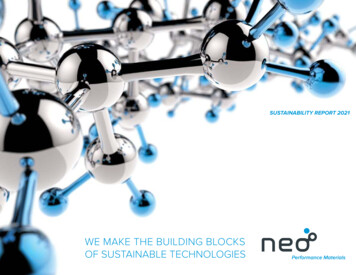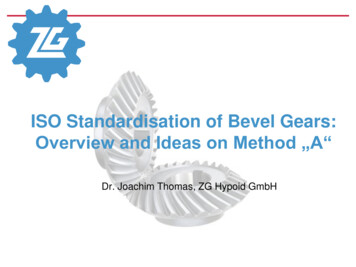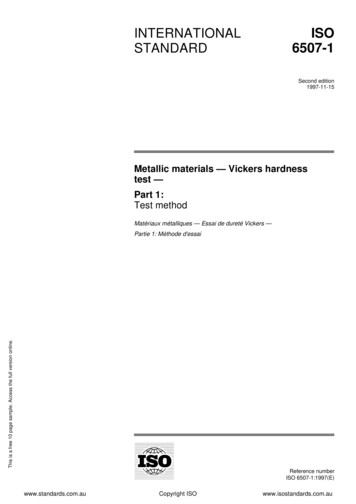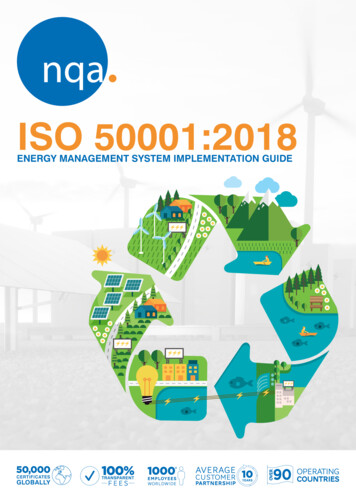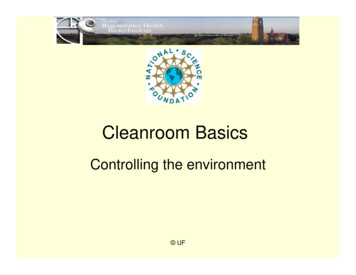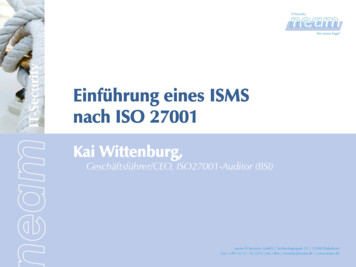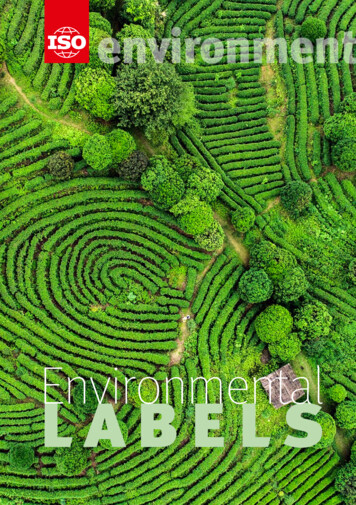
Transcription
environmentEnvironmentallabels
Environmentallabels
With increasingconsumer concern aboutthe environmental impactof the goods and servicesthey buy, environmentallabelling has emergedas a key tool for makingsustainable purchasingdecisions.The commercial benefits of environmental labelling forboth buyers and suppliers has given rise to a multitudeof environmental claims, labelling schemes and initiatives, each offering different measures and benchmarks.This has increased the awareness of the environmentalimpact of products and services, but not without someconfusion in the market. The ISO range of standards forenvironmental labels and claims helps to make senseof it all, providing harmonized criteria, definitions andguidelines for the many labels, claims and declarationsthat are prevalent in today’s marketplace.ISO Environmental labels – 1
Why do we need ISO standardsfor environmental labels ?Environmental labels provide information about a product or service interms of its overall environmental benefits, such as the recyclability of itspackaging, or the absence of noxious ingredients. At a time when moreand more consumers are motivated to purchase environmentally benignproducts, this information can positively influence consumer choices,creating a win-win situation for all. However, the increasing proliferationof such labelling has led to concerns of ’greenwashing’ and exaggeratedmarketing claims. What is needed, therefore, are internationally agreedand harmonized criteria and methods of labelling to provide a credibleand level playing field. This is where ISO International Standards play afundamental role.Who develops ISO standards for environmental labels ?ISO standards are developed by groups of experts within technicalcommittees (TCs). TCs are made up of representatives and internationalexperts from industry, non-governmental organizations, governmentsand other stakeholders who are put forward by ISO and its members fromall over the world. Each TC deals with a different subject or specialist area.ISO/TC 207/SC 3, Environmental labelling, is a subcommitteeof ISO/TC 207, Environmental management, and is the hub for thedevelopment of standards for environmental labelling. It consists of expertsfrom 78 countries and has published six standards to date.2 – ISO Environmental labels
Who benefitsfrom ISO standardsfor environmental labels ?IndustryISO standards for environmental labels help busi-nesses create their own environmental labellingthat effectively and accurately describes theirproducts in a way that instills loyalty and trustin their customers.ConsumersConsumers benefit when businesses use ISOstandards to provide clear and accurate information that can be easily compared with otherproducts and services.RegulatorsRegulators can rely on ISO standards as a solidbase on which to create public policy thatmeets international commitments, in additionto helping them establish and measure criteriafor environmentally-related incentive schemes.ISO standards also help regulators address themany challenges that climate change brings.ISO Environmental labels – 3
What kinds of environmental labelsdo ISO standards cover ? Type I environmental labelling for eco-labelling schemes where there are clearly defined criteria for products Type II self-declared environmental claims for products and services where there are neither criteria nor labelling schemes Type III environmental declarations for specific aspects of products using a life-cycle approach4 – ISO Environmental labels
What standards does ISO havefor environmental labels ?The ISO 14020 series of standards provides businesses with an internationallyrecognized and agreed set of benchmarks against which they can prepare theirown environmental labels, claims and declarations.These include :General principles ISO 14020, Environmental labels and declarations – General principles,establishes the guiding principles for the development and useof environmental labels and declarations.It is aimed at businesses wanting to develop an environmental label or claim,as it describes the principles to ensure they provide accurate and credible information. It outlines the principles that underpin all the other standards in the14020 series and can be used by those making environmental claims for whichspecific standards have not yet been developed.Nordic Swan Ecolabel : The official ecolabel of the Nordic countries (www.nordic-ecolabel.org)
Eco labelling schemes ISO 14024, Environmental labels and declarations –Type I environmental labelling – Principles andprocedures, outlines the requirements for developing“ Type I environmental labelling programmes ”,more commonly known as ecolabelling schemes.These schemes award a mark or logo to productsor services upon fulfilling a set of criteria.ISO 14024 features the principles and procedures for select-ing product categories, product-environmental criteria,product-function characteristics and for assessing and demonstrating compliance. It also establishes the certificationprocedures for awarding the label.Internationally recognized, ISO 14024 has been adoptedas a benchmark for environmental labels by the GlobalEcolabelling Network (GEN), the international federationof ecolabelling bodies.
Self-declared environmental claimsWhere there is no eco-labelling scheme to verify environmental claims,it is essential to have a means of demonstrating the reliability of selfdeclared information. This will help to avoid confusion, barriers to tradeand unfair competition. ISO 14021, Environmental labels and declarations– Self-declared environmental claims (Type II environmental labelling),can provide credibility for environmental claims that manufacturers,marketeers and resellers can make for products or services.ISO 14021 identifies and clarifies a number of commonly used termsused in claims, whether they be on the product or elsewhere such asin product literature, advertising or reports. It also details the evaluation methods for each term in order to help ensure they are valid andscientifically sound.In addition, ISO 14021 has a comprehensive list of general requirementsfor the use of other terms that are not already defined. It also describesother label-related information and guidance, such as the use, placementand size of symbols and graphics.
Life cycle data declarationsDeclarations that show quantifiedenvironmental information on thelife-cycle of a product enable comparisons between similar products. Theyalso are useful when fulfilling regulatory requirements and in business-tobusiness communications. Commonlyknown as Environmental Product Data(EPD) sheets, they represent the “ nutrition labels for the environment ”. Suchlabels provide display informationand data that consumers can use toassess and compare the environmentalimpacts of products and services. ISO 14025, Environmental labelsand declarations – Type IIIenvironmental declarations– Principles and procedures,establishes the principles andprocedures for developing thedata for such declarations andthe requirements for declarationprogrammes, includingthe requirement that dataare independently verified.8 – ISO Environmental labels
Footprint CommunicationProduct category rules ISO 14026, Environmental labelsand declarations – Principles,Product category rules (PCRs) are necessary when implementing standardsrequirements and guidelinesfor product-related environmentalfor communication of footprintclaims. They enable comparability ofinformation, provides guidancedata that is produced to support envi-on how to communicateronmental claims and declarationsenvironmental footprintHowever, there are many in existenceinformation in a transparentand their quality varies.and robust way. It outlinesinternationally agreed termsand definitions for footprintdeclarations. ISO/TS 14027, Environmental labelsand declarations – Developmentof product category rules,is an internationally agreedISO 14026 describes the requirementsset of principles, requirementsfor determining which environmentaland guidelines for developingaspects are covered by the footprintquality PCR that can be widelydata, ensuring that the information isused and understood.transparent and clearly understood.It also provides the requirements forestablishing a communication programme for footprints.ISO Environmental labels – 9
About ISOISO (International Organization for Standardi-zation) is an independent, non-governmentalinternational organization with a membershipof 164* national standards bodies. Through itsmembers, it brings together experts to shareknowledge and develop voluntary, consensusbased, market-relevant International Standardsthat support innovation and provide solutions toglobal challenges.ISO has published more than 22 500* Interna-tional Standards and related documents coveringalmost every industry, from technology to foodsafety, to agriculture and healthcare.For more information, please visit www.iso.org*June 2019International Organizationfor StandardizationISO Central SecretariatCh. de Blandonnet 8Case Postale 401CH – 1214 Vernier, GenevaSwitzerlandiso.org ISO, 2019All rights reservedISBN 978-92-67-10982-4
and other stakeholders who are put forward by ISO and its members from all over the world. Each TC deals with a different subject or specialist area. ISO/TC 207/SC 3, Environmental labelling, is a subcommittee of ISO/TC 207, Environmental management, and is the hub for the development of standards for environmental labelling. It consists of experts

